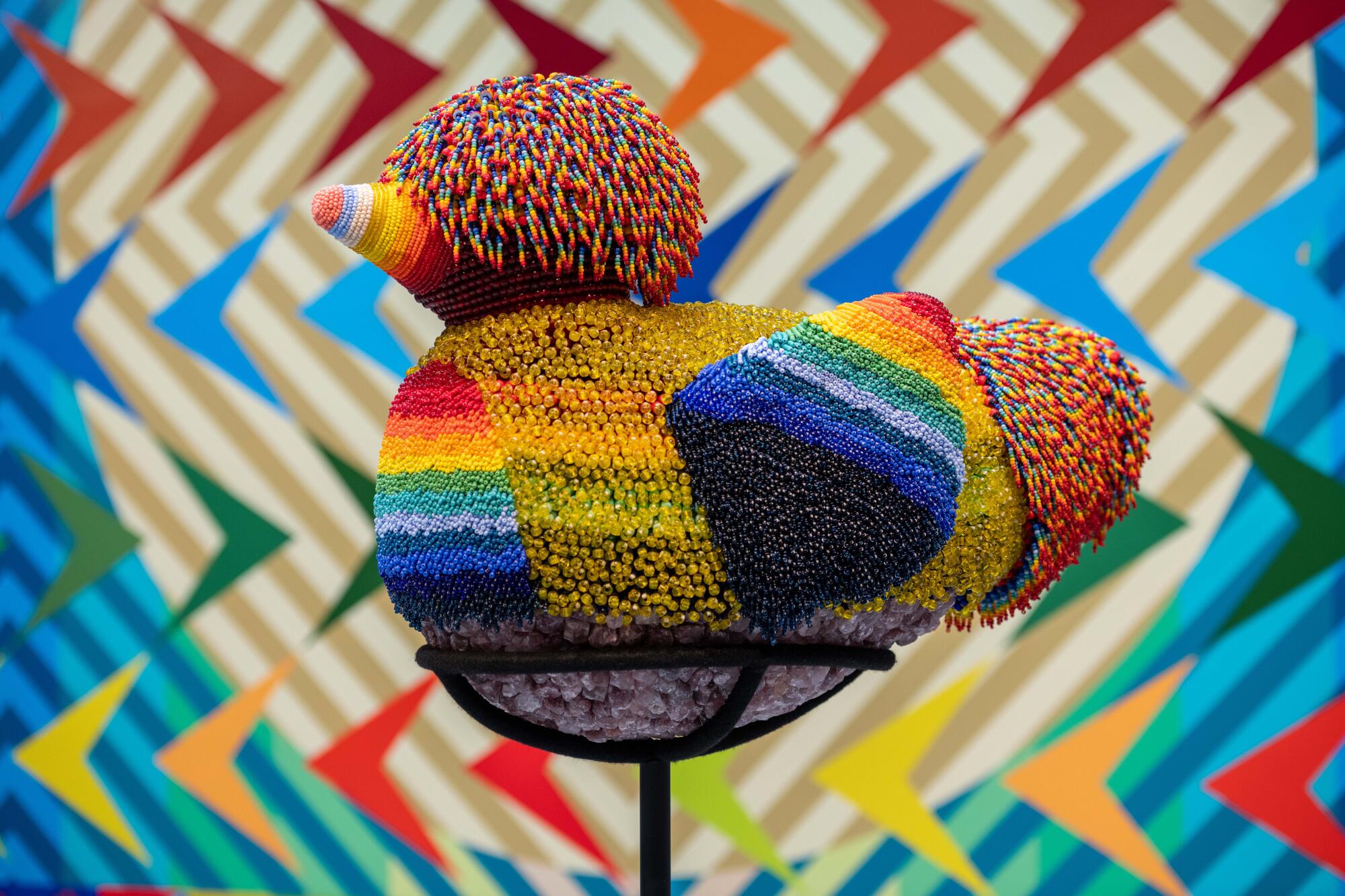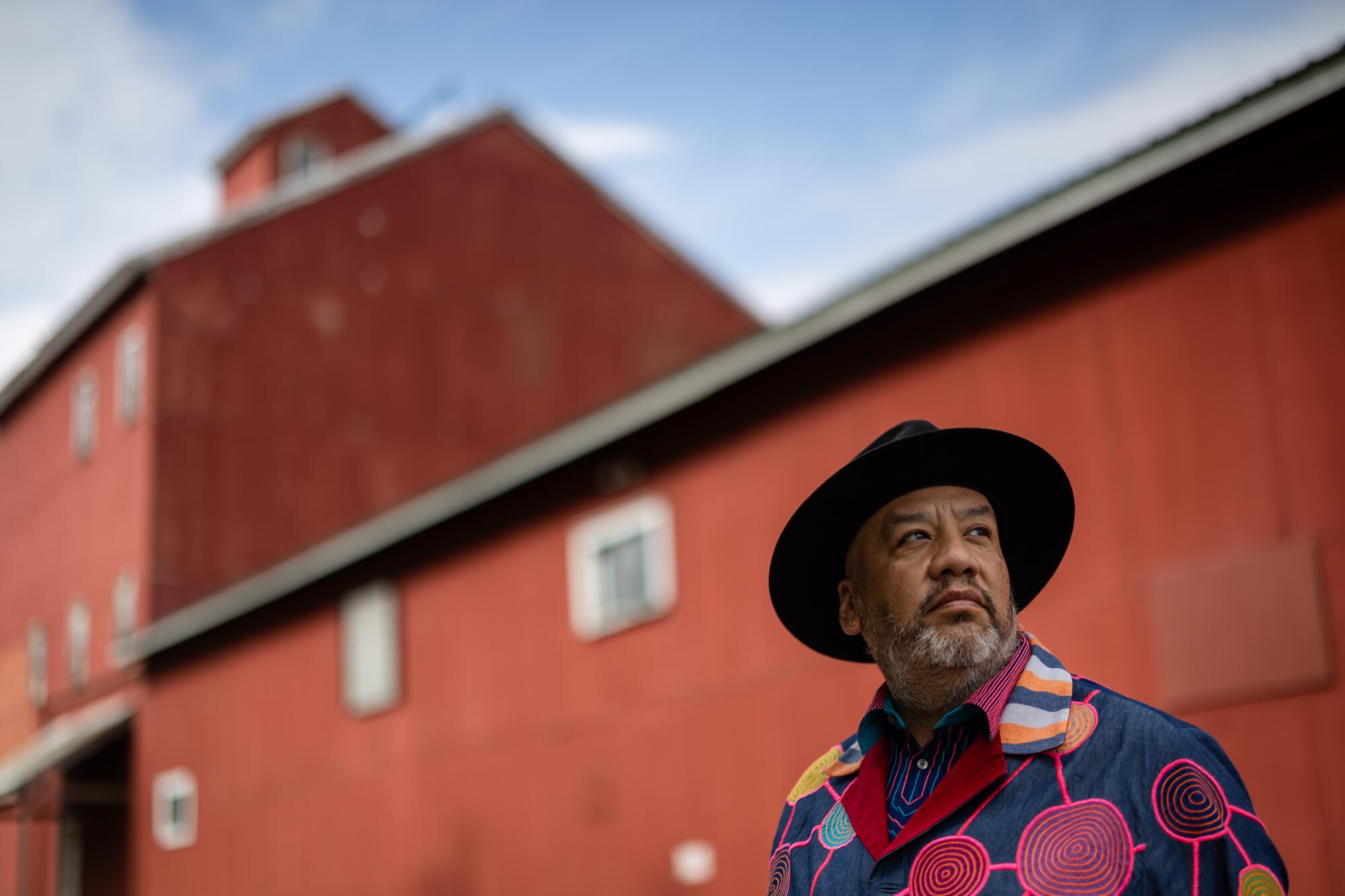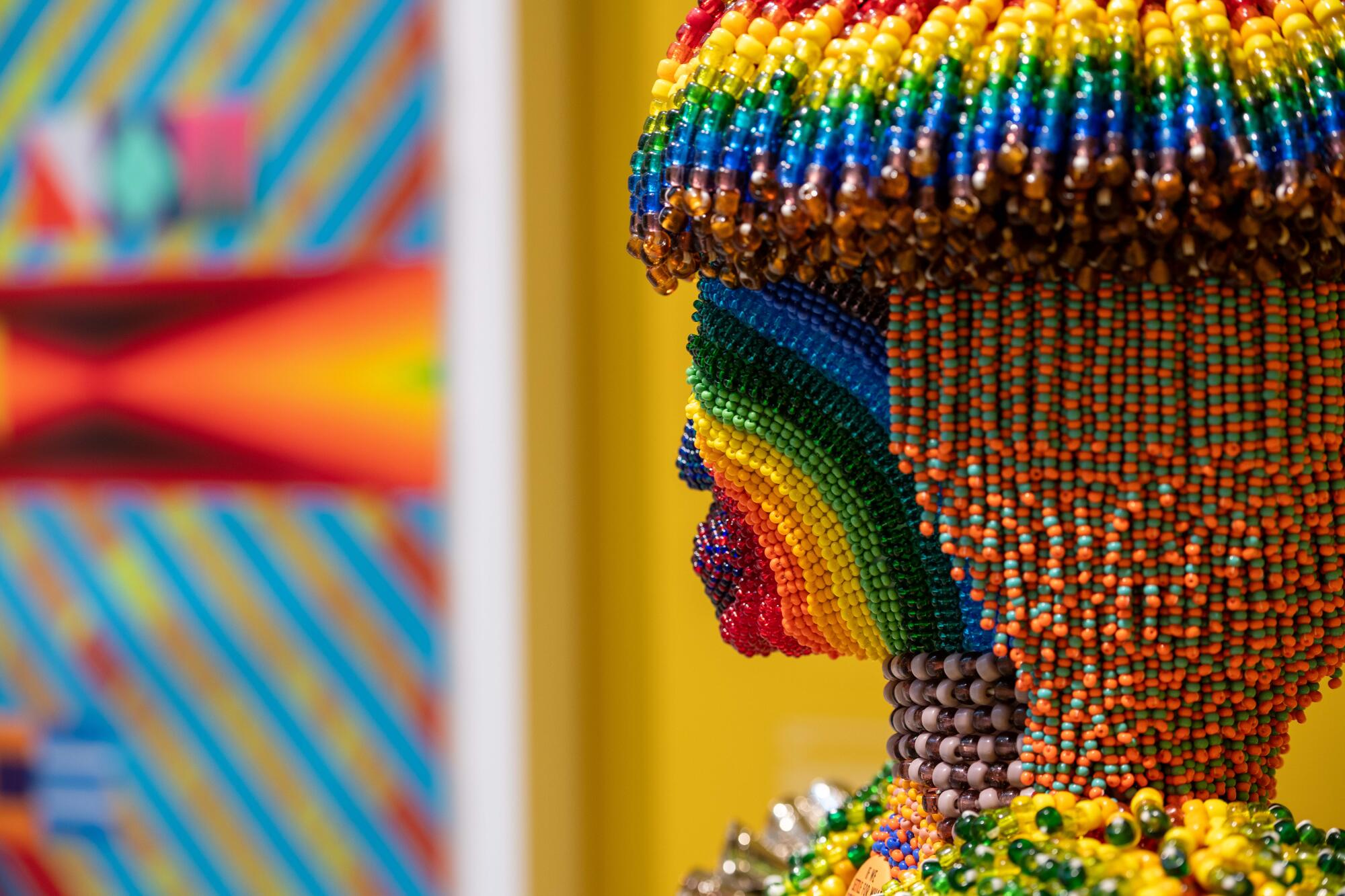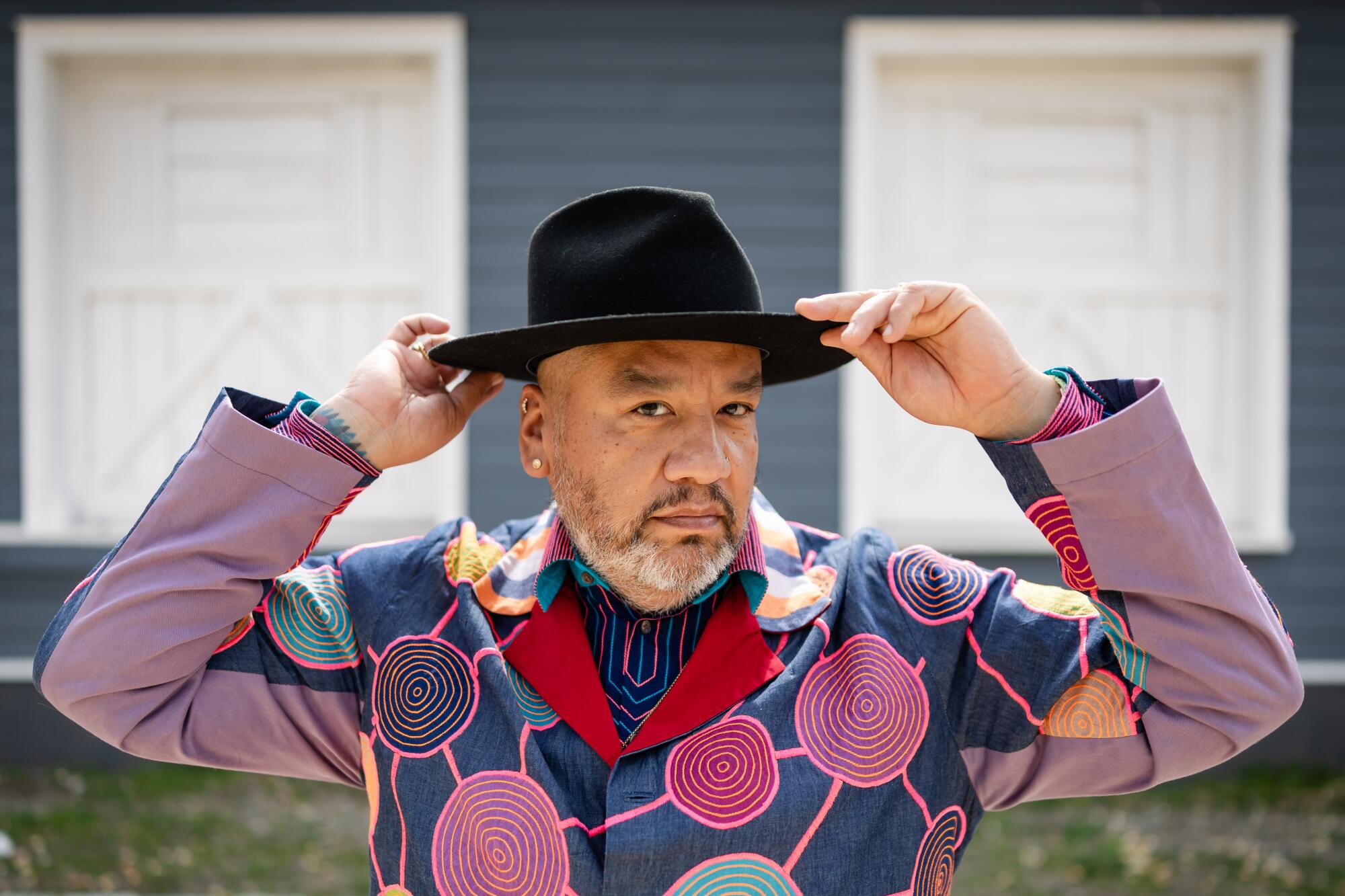In 2019, Jeffrey Gibson received a MacArthur Fellowship, the $625,000 award commonly called “the genius grant” that buys recipients the freedom to follow their dreams.
Gibson used the money to purchase art materials and hire studio assistants. He took a two-year hiatus from teaching and spent more time reading. Best of all, he could afford to focus on the exquisitely crafted and increasingly ambitious art — supercharged with bold patterns, bright colors, poetic messages and mesmerizing textures — coming out of his studio in upstate New York, near the town of Hudson, where he lives with his husband, artist Rune Olsen, and their children, 9-year-old Gigi and 5-year-old Phoenix.
A sequence of critically acclaimed — and wildly popular — exhibitions followed: “When Fire Is Applied to a Stone It Cracks” at the Brooklyn Museum in 2020, “The Body Electric” at SITE Santa Fe in New Mexico in 2022, “The Spirits Are Laughing” at the Aspen Art Museum in Colorado that same year, “They Teach Love” at the Jordan Schnitzer Museum of Art at Washington State University in 2023 and “Power Full Because We’re Different” at the Massachusetts Museum of Contemporary Art in 2024.
The pace of Gibson’s exhibitions was relentless. He gained energy and momentum from reaching larger audiences, and he became a passionate advocate for issues dear to his heart, speaking particularly in terms of power and beauty, and the ways those forces have played out — and continue to play out — in the democratic experiment that is the United States of America.
All of that culminated in 2023, when the State Department selected Gibson to represent the United States with a solo exhibition at the 60th Venice Biennale in 2024. There are few higher honors for an American artist, and Gibson, a member of the Mississippi Band of Choctaw Indians who also is of Cherokee descent, was the first Indigenous artist selected to fill that role. Other Indigenous artists, often unnamed, had represented the U.S. only once before — mostly with pottery, jewelry and textiles — as part of a group exhibition. That was in 1932, when Pueblo artists Ma Pe Wi and Tonita Peña and Hopi artist Fred Kabotie also exhibited their paintings.
Jeffrey Gibson’s exhibition at the 2024 Venice Biennial transformed the neoclassical U.S. Pavilion with dramatic works like this beaded piece, which is part of the forthcoming show at the Broad museum in downtown L.A.
(Timothy Schenck)
“Jeffrey Gibson: the space in which to place me” transformed the exterior and the interior of the neoclassical U.S. Pavilion in Venice into a vibrant stage that invited people from all walks of life to interact with the cornucopia of works. Visitors couldn’t help but discover something wonderful, whether it be a giant, stylized bird, festooned with thousands of glistening beads; a laser-sharp painting, composed of up to 290 supersaturated colors; an array of lavishly patterned flags, from places no one has ever visited; or an evocative phrase, lifted from a novel, a pop song, a poem or a document, such as the U.S. Constitution. A pair of 9-foot-tall figures looked like they had just stepped off a spaceship — or out of a psychedelic fever dream. And a trio of murals, measuring up to 18-by-40 feet, provided an intergalactic backdrop, welcoming aliens of all stripes.
That historic, well-received exhibition in Italy — “Identity politics has never looked this joyful,” read the review from the Times of London — has come to Los Angeles. Gibson’s first solo show in a Southern California museum opens May 10 in the lobby and first-floor galleries of the Broad.

Hypnotically colorful artworks by Jeffrey Gibson in the U.S. Pavilion of the 2024 Venice Bienniale.
(Timothy Schenck)

Detail of Jeffrey Gibson’s Venice Bienniale artworks, which have been reinstalled at L.A.’s Broad museum.
(Timothy Schenck)
All of the works that filled the pavilion in Venice will be at the Broad, installed to let visitors circulate freely through a layered labyrinth of figures and forms — some familiar, others disconcerting. A pair of sculptures, displayed five years ago in Gibson’s Brooklyn Museum exhibition, has been added.

For “When Fire Is a Applied to a Stone It Cracks” at the Brooklyn Museum in 2020, Jeffrey Gibson installed moccasins to an early 20th century bronze by Charles Cary Rumsey titled “The Dying Indian.”
(Jonathan Dorado)
The larger of the two is a monumental bronze figure on horseback, cast by Beaux-Arts sculptor Charles Cary Rumsey in the first decade of the 20th century and titled “The Dying Indian.” It depicts a generic Native American man astride an emaciated horse. Shoulders slouched, head bowed and wearing nothing but a pair of moccasins, the dying Indian is an emblem of extinction — or extermination.
To counteract that narrative, Gibson commissioned Pawnee-Cree artist John Little Sun Murie to create a pair of beaded moccasins emblazoned with a line from a Roberta Flack song: “I’m gonna run with every minute I can borrow.” While giving symbolic comfort to the bronze figure, the buckskin moccasins tell a story of grassroots resistance and DIY defiance, in which beauty and comfort and love have a toehold, even in a world otherwise defined by injustice and suffering.

Artist Jeffrey Gibson.
(Matthew Cavanaugh / For The Times)
“The space in which to place me” comes at a fraught moment for artists and their art, and Gibson is acutely aware of where his work stands in the current political climate.
“To me it’s almost whiplash going from Venice to what’s going on at the Smithsonian now,” Gibson says, referring to the public-private institution that includes the National Museum of the American Indian in Washington, D.C. Under pressure from the Trump administration, the Smithsonian closed its Office of Diversity and is targeted by the president for “race-centered ideology” that he deems “improper” under an executive order titled “Restoring Truth and Sanity to American History.”
“I don’t want to say it’s actually hard to reckon, because I’m not sure that it is that hard to reckon,” Gibson says. “I think that, in this moment, we have no distance. We have no objective distance from what we’re experiencing right now. And so there’s no way for me to be able to understand all of the circumstances that led to where we’re at.”

Detail of Gibson’s work at the Venice Bienniale.
(Timothy Schenck)
When Gibson looks at the present, he sees it as part of history, reaching back further than the divisiveness that has defined American politics for the last couple of decades. “When we look at other moments in history, you see so clearly how events and attitudes and interests aligned for those moments to happen.”
Gibson is convinced that, in the future, when we can see the present in retrospect, we will see that the current turmoil is actually business as usual.
Sarah Loyer, curator and exhibitions manager of the Broad, puts it this way: “The show takes a long view of history. It’s not reactive. It’s not about the past 10, 20, or however many years. It’s really looking all the way back.
“In this moment, that is refreshing. It is also necessary for us to ground ourselves in this longer view, this longer arc, and really think about the role of history, and how that affects the present and the future.”

Gibson photographed earlier this month at his studio in upstate New York.
(Matthew Cavanaugh / For The Times)
Jeffrey Gibson was born in 1972 in Colorado Springs, Colo., and he grew up in West Germany and South Korea, where his father worked for the U.S. Department of Defense, supplying goods to military bases.
In 1995, Gibson earned his bachelor’s degree from the Art Institute of Chicago. As an undergrad, he had worked at the Field Museum, on the staff established by the Native American Graves Protection and Repatriation Act, which returned sacred objects and human remains to their respective tribes.
After receiving his master of fine arts degree from the Royal College of Art in London in 1998 — funded in part by the Mississippi Band of Choctaw Indians — Gibson moved to New York City, where he, like many young artists, struggled to find his voice, struggled to find an audience for his art and struggled to find time to make art between day jobs at Macy’s and Ikea.
By 2011, Gibson was frustrated by all of the struggles and considered abandoning art. But a 2012 two-gallery exhibition in New York, titled “one becomes the other” and presented at Participant Inc. and American Contemporary, redeemed his commitment to art-making. For the first time Gibson collaborated with other Indigenous artists, who specialized in beading, drum-making and silver engraving. It was also the first time he felt that people understood what he was up to as an artist.
Interest in his work spread swiftly. Solo exhibitions at public venues around the country followed: “Love Song” at the Institute of Contemporary Art, Boston, in 2013, “Speak to Me” at the Oklahoma Contemporary Arts Center in 2017, “Like a Hammer” at the Denver Art Museum in 2018 and “I Was Here” at the Des Moines Art Center in 2019.
He was 48 when he got the MacArthur.
For Venice, Gibson dreamed big. Rather than proposing what he thought was practical, or acceptable, or typical, he proposed what he wanted to see — in his most freewheeling imaginings, with no compromises or constraints. From June 2023, when he found out that his exhibition proposal had been selected, to April 2024, when his exhibition opened, he says, “I was prepared the entire time for people to call me and say, about every element of the installation, ‘We just can’t do that,’ or ‘It’s just not possible.’ And I have to say, that didn’t happen.”
That’s a testament to the team Gibson had assembled, which ultimately consisted of 180 people. Chief among them were Kathleen Ash-Milby, curator of Native American Art at the Portland Art Museum, and Abigail Winograd, an independent curator, as well as Louis Grachos, executive director of SITE Santa Fe. Gibson’s exhibition was co-commissioned by SITE Santa Fe and the Portland museum.

A rainbow of beads form a dreadlocked bust, one of Gibson’s works on view at the Venice Bienniale.
(Timothy Schenck)
“What’s so amazing about Jeffrey is that he draws on so many different realms for his work, from Indigenous histories to American queer culture, all the while exploring identities and diversity,” Grachos says, “He is an exceptionally sophisticated colorist, a great communicator and an effective educator. In the end, Jeffrey is the absolute, consummate humanist.”
Looking back at the year leading up to the Venice opening and the year that followed, Gibson has a deep appreciation of the value of time — and how long it takes to make sense of things. And that worries him deeply about the world we live in.
“We have created a culture that is overwhelming for a human being,” Gibson says. “And that overwhelming causes anxiety. It causes fear. It causes a real, not just a perceived, sense of instability. And when we feel completely unstable, the first thing we want to do is revert to something that we think we understand. We’ve taken away the ability to feel that we have the space for comprehension, the space to process and to understand.”
When face-to-face understanding gives way to stereotypes developed from a distance, Gibson says, the battle is lost. “We are again conjuring fear. And that fear ultimately sits in the soul as resentment. That resentment is going to show up. So when I look at the world right now, I think what I really see is fear.”
Gibson’s art is all about making a place in the world where fear — the feeling of being overwhelmed by the speed and volume of modern life, the seemingly intractable political divide, the malignant racism that plagues the nation — has no toehold, much less a leg to stand on.
Gibson’s exhibition is a remedy for those who sometimes feel powerless and pointless. His exuberant, color-saturated installation serves up an abundance of beauty, awe, astonishment and fun. It stimulates the senses and inspires the mind. Most of all, it uplifts. The experience is the opposite of what one feels by the image glut and sound bites of modern life, the psychologically destabilizing ether of digital distractions that can oppress the soul.
“I think that analog-world engagement is crucial,” Gibson says. “I make work that’s very much about being a living being in this world, which I see as phenomenal. And I wish for people that they could understand how phenomenal the world around us is.”

“We Want to Be Free,” courtesy of Jeffrey Gibson Studio, will be on view in the upcoming Broad museum exhibition.
(A garment of flowing yellow, orange and yellow carries the beaded message “ We want to be free.”)
Until recently, Gibson had not realized how important working with textiles and making garments would be to him. “When displayed,” he says, “the garments become a kind of banner, a kind of flag.”
They evoke the regalia worn by ghost dancers, papal robes and the outfits created by such performance artists as Magdalena Abakanowicz, Hermann Nitsch and Hélio Oiticica. They also recall the homemade clothes of punks and skaters.
“The garment is really a mechanism for transformation,” Gibson says. “You become someone other in the garment. It’s a way of extracting yourself from mass consumer culture. And all of those things just really fascinated me to want to think about an alternative, progressive, very inclusive army.”
The repetitive nature of weaving and beading and hands-on craftsmanship are important to Gibson. “The routine is healing,” he says.
During an earlier visit to Venice, Gibson was struck by gorgeous, fully beaded dresses made centuries ago. “They were made under some periods of tremendous distress,” he says. “I wondered why anybody, under those conditions, decided to make a beautiful, beaded dress. Why was beauty so important? And that question — Why beauty? — is still with me. The only answer I can come up with is that, in a weird way, beauty is a manifestation of hope.”

“I’m not a religious person per se, but more and more I feel that faith, in its broadest definition, is crucial,” Gibson says.
(Matthew Cavanaugh/For The Times)
Gibson also notes that the handing down of a treasured object to a family member or community member “is really a way of manifesting a future. It may be a small gesture, but it’s powerful.”
That’s how he looks at his life as an artist: “It all starts at a much smaller scale. It starts in childhood. It starts with socialization. It starts with people having examples of equity and fairness to mimic. If you have those examples, you really lessen the degree of violence that we see in society today.
“I know that’s not a sexy story. But I think that those things are within my control. I’m not a religious person per se, but more and more I feel that faith, in its broadest definition, is crucial. Right now. I just think that once you lose faith, hope, love — I mean, I don’t know what’s left.”
‘Jeffrey Gibson: the space in which to place me’
Where: The Broad, 221 S. Grand Ave., L.A.
When: May 10-Sept. 28; closed Mondays
Admission: $12-$15 for this special exhibition; kids 17 and younger are free
Information: (213) 232-6200, thebroad.org




